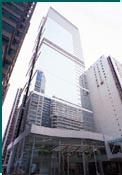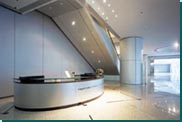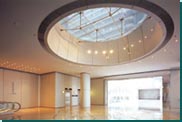| March
2000 |

 |
|
|
Oxford House, Quarry Bay
Campus connection
It is city planning in
miniature, but after years of patient acquisition and thoughtful
development, Swire Properties has succeeded in creating a little
model to which urban planners may refer. The subject in question
is TaiKoo Place and Taikoo Shing; that area in Quarry Bay which
was once a faceless industrial outpost of developing Hong Kong
 In
the mid-1970s, in tandem with the construction of the Mass Transit
Railway Island Line, Swire began the transformation of Quarry Bay
with the development of Taikoo Shing, a massive residential complex
with 13,000 flats in 61 towers. In the mid-1980s, in a seemingly
separate development not far away, Swire gradually began to transform
its industrial estate into an office complex that boasts Grade A
accommodation, convenient transport via the MTR and Island Eastern
Corridor, and off-centre rental. In
the mid-1970s, in tandem with the construction of the Mass Transit
Railway Island Line, Swire began the transformation of Quarry Bay
with the development of Taikoo Shing, a massive residential complex
with 13,000 flats in 61 towers. In the mid-1980s, in a seemingly
separate development not far away, Swire gradually began to transform
its industrial estate into an office complex that boasts Grade A
accommodation, convenient transport via the MTR and Island Eastern
Corridor, and off-centre rental.
TaiKoo Place, as it
came to be called, was to be turned into what architect Wong &
Ouyang called a "commercial campus" with its associated
sense of community and coherence, achieved through a common architectural
language and an orchestrated experience through a flowing, continuous
podium spanning all the buildings in the development.
Grand as this plan is, the developer's plans are in fact grander,
although this did not become apparent until recently, when Oxford
House was completed.
Originally an industrial building owned by a printing firm, Oxford
House is located at the eastern tip of TaiKoo Place, where it serves
as the vital link that connects the office complex with the residential
community of Taikoo Shing.
From a landscaped garden christened Via Fiori that marks the boundary
between the two developments, pedestrians can now step into the
airy lobby of Oxford House, ride the escalator to the first floor,
and begin their journey through the commercial campus.
Key to the sense of a continuous first floor pathway is the creation
of bridge links that blend seamlessly with the podiums which they
are built to connect. To that end, Oxford House comes with a bridge
of a height and volume designed to make it an integral part of the
podium. Its treatment also echoes that of the building from which
it springs.
To bring as much natural
light into the public areas as possible and to enhance the sense
of airy spaciousness, the podium of Oxford House is clad in full-height
glazing secured by a spider fixing system. Glass panels are held
in place by unobtrusive, spider-like members which are in turn secured
by a system of masts and cables set back from the facade, thus making
it possible to enclose a space with continous spans of glass without
mullions. This cladding system is extended to the bridge which,
according to the architect, is 80 per cent transparent as a result.
Although part of the
same development, the Oxford House bridge is treated entirely differently
from the Lincoln House bridge due to programming and structural
reasons.
Designed as a spaceframe,
the shorter (20 m) Lincoln House bridge was supported at both ends
when built; by contrast, the Oxford House bridge was built with
support at the Oxford House end only. The bridge was consequently
designed as a tension truss system with its 30 m span held up by
diagonal members. A system of temporary support was erected to support
the bridge in the middle during construction and was taken down
when the whole structure was hung on temporary anchors on Somerset
House. This arrangement makes it possible to provide a permanent
bridge link to Oxford House now, regardless of the overall development
schedule for the whole estate.
The transition from bridge to podium is marked by a skylight designed
to bring more natural light into the lift lobby as well as to accentuate
the end of the bridge. Office workers will be circulated into the
building via the bridge and two sets of escalators serving the Taikoo
Shing entrance into the building and the vehicular entrance respectively.
Paved in the trademark red bricks of TaiKoo Place, the vehicular
entrance features a unique glass canopy which is the happy result
of the search for a transparent solution. According to the architect,
the original design for the entrance did not feature a canopy, as
the intention was for the ground floor lobby, enclosed by a glass
wall, to achieve maximum transparency. However, the need for a sheltered
taxi dropoff was recognised at a later stage of the project, and
the architect was instructed to design a canopy after all.
Given the desire to maintain maximum transparency, glass was chosen
early as the cover material for the canopy roof. However, since
the glass wall of the lobby was not designed to support a canopy,
how could this structure be supported? In the search for a structurally
expressive yet simple form of support, the architect finally designed
two tree-like stainless steel columns. The material was chosen because
it would complement the anodised aluminium highlights of the building
and the stainless steel of the spider fixing system. The columns
also double as drainage channels in a design which marries function
and aesthetics -- by angling the canopy to slope backwards towards
the glass wall, an unobtrusive gutter can be provided to collect
rainwater for drainage through pipes within the columns while leaving
a clear glass span in front.
The canopy design, once approved, was extended to the 25 m long,
10 m wide walkway between Oxford House and Taikoo Shing, where panels
of glass, also secured by a spider fixing system, are supported
by five pairs of "trees", creating a vaulting effect.
This solution not only maintains unity of design throughout the
project, but also satisfies the client's wish to maintain the harbour
vista enjoyed by the walkway, for which reason it was raised to
a height of 6 m.
In response to the client's wish to have a simple, easy-to-maintain
building, Oxford House was designed as a sleek rectangular building
with interlocking forms to add interest to its external articulation.
It is clad in a silver reflective double glazed curtain wall with
anodised aluminium bands as highlights. It has 41 floors and five
basement levels providing a total gross floor area of 502,000 sq
ft and 183 parking spaces.
In order to take advantage of the harbour vista to the north while
avoiding a 30-storey building which stands in the way, the architect
pushed the building towards the eastern boundary of the site. This
allows all floors to have a view of the harbour in the northeast
corner, while all floors above the 30th enjoy a sweeping seaview.
A single-sided lift
core was placed in the southeast corner, resulting in a very efficient,
L-shaped floor plate with a 12,900 sq ft floor plan. This layout
also helps to relate the building to the rest of the TaiKoo Place
development to its west. The building is served by 12 high-speed
passenger lifts divided into three zones.
To maintain the airy beauty of the podium, a large, rigidly tensioned
truss was installed in the podium roof, so that the space can remain
uncluttered by any horizontal member. The podium's elegant atmosphere
is enhanced by white marble and granite floors and subtle lighting
complemented by artworks. A 13 m tall painting by Japanese artist
Makato Fujimura will adorn the northern wall of the core while two
murals by Estonian artist Zoya Frolova will be installed on the
western wall. Other bronze sculptures for the lobby areas are currently
being explored.
According to the architect, the building is intended to be seen
mainly from the west, where it faces the rest of TaiKoo Place; and
the east, where it faces Taikoo Shing. Thus, instead of having a
big blank wall reflecting the fact that the core occupies most of
the building's eastern side, the architect extended the glazing
to cover the eastern facade, using the exposed, functional louvres
of the plant rooms to add interest.
Swire has given much thought to the comfort and convenience of its
tenants. Creating a fully-conditioned, continuous podium encompassing
the link bridges and installing public art are only part of the
strategy to enhance the quality of the development. The company
has also taken pains to acquire ground floor properties in the area.
These are transformed into shops and eateries which serve as support
structures for the offices and add life to the district as a whole.
This mini-city between Quarry Bay and Tai Koo MTR stations is still
undergoing transformation. Even so, there is no disputing the success
of Swire in creating a clean, vibrant locale in which TaiKoo Place
and the office/retail complex Cityplaza will provide employment
and entertainment for a self-contained, sizeable community which
can work, shop and play, all within walking distance of home.
architect/interior
designer Wong & Ouyang (HK) Ltd
developer Swire Properties
main contractor Gammon
Construction Ltd
|

 In
the mid-1970s, in tandem with the construction of the Mass Transit
Railway Island Line, Swire began the transformation of Quarry Bay
with the development of Taikoo Shing, a massive residential complex
with 13,000 flats in 61 towers. In the mid-1980s, in a seemingly
separate development not far away, Swire gradually began to transform
its industrial estate into an office complex that boasts Grade A
accommodation, convenient transport via the MTR and Island Eastern
Corridor, and off-centre rental.
In
the mid-1970s, in tandem with the construction of the Mass Transit
Railway Island Line, Swire began the transformation of Quarry Bay
with the development of Taikoo Shing, a massive residential complex
with 13,000 flats in 61 towers. In the mid-1980s, in a seemingly
separate development not far away, Swire gradually began to transform
its industrial estate into an office complex that boasts Grade A
accommodation, convenient transport via the MTR and Island Eastern
Corridor, and off-centre rental. 